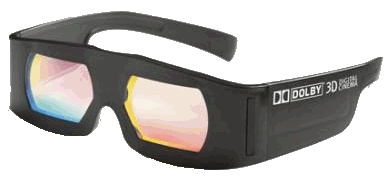Which 3D Theater to Choose?
RealD 3D vs. IMAX 3D vs. Dolby 3D
RealD 3D is currently the most popular form of 3D technology used in theaters. RealD 3D uses circular polarized light with special polarized glasses so that the left & right eyes see a slightly different picture. By using circular polarization, the viewer can move their head left & right and will still be able to see the 3D effect.
IMAX 3D uses a much larger screen and a much larger film size over traditional film screens. IMAX theaters are huge and impressive displays with big sound and stadium seating that puts you right in front of the screen. Sill, most IMAX theaters uses an older analog technology that uses linear polarization on the 3D glasses. With these glasses, if the viewer moves their head the 3D effect will be lost. This can cause headaches and nausea with some people if they are not staring directly at the screen. With such a large screen some head movement is natural. IMAX is just starting to introduce digital projectors with LCD shutter glasses (more on this later), which solves the problems with the older IMAX technology. These digital systems are not available in most areas so check with your theater first.
Dolby 3D is the newest 3D technology and from a pure 3D standpoint is the best technology for viewing 3D movies. The polarized glasses are more expensive than IMAX or Real 3D glasses and for good reason. Each lens on the Dolby 3D glasses contain a different set of multiple coatings to filter out specific light frequencies. The lenses are also curved for a better effect. Dolby 3D is your best bet for a headache free 3D viewing experience, but as with any new digital theater technology, it is hard to find.
3D Stereoscopic glasses are your classic paper Red-Cyan glasses originally used for 3D movies. The red lens filters out red light and the cyan lens filters out the cyan colors, so that each eye effectively sees a different image. This technology is still worth mentioning as you will still see it used for TV movies or books, but the theater industry is moving toward digital movies and polarization.
How 3D WorksIn the real world, each of your eyes see a slightly different image due to the fact that they are a couple of inches apart. If you hold one of your fingers right in front of your nose you will notice that you can see everything behind your finger. Whatever your finger is blocking from the left eye can be seen by the right eye. Your brain is capable of determining distance based on the differences between what the left and right eyes see.
Theaters use the same principle to produce a 3D effect. The 3D glasses (polarized, stereoscopic, or LCD shutter) are all designed to ensure that the left and right eyes see different things. Some 3D technologies require a special projector, a special screen or both. Some technologies can be used at home on an LCD TV and others require a projector and a screen.
How Polarization WorksPolarized 3D glasses work in the same way that polarized sunglasses block sunlight. Polarized sunglasses block any light that is horizontally polarized - typically light reflected off of a flat surface on the ground. Polarized 3D glasses have one lens that blocks horizontally polarized light and one lens that blocks vertically polarized light. This allows the projector to provide a different picture to each eye.
Note that polarized 3D glasses should never be used as sunglasses, while they do block some sunlight, they do not have any UV protection. Therefore, the glasses will cause your pupil to enlarge since less sunlight is reaching your eye, but this allows even more UV radiation to reach your eye which could damage your eyes - similar to staring at the sun.
How 3D LCD Shutter Glasses WorkThe small LCD screens in front of the left and right eyes in LCD Shutter Glasses rapidly blink at alternating times. When the projector displays an image intended for the right eye, the LCD screen in front of the left eye activates to block any light from reaching the left eye. Then a split second later, the projector shows an image for the left eye, and the LCD glasses block the right eye from seeing that image. Although this allows the left and right eyes to see completely different images, half the time each eye will see nothing. If this blinking is done fast enough then the brain will compensate and you wont realize that your glasses are blinking.
In an digital 3D IMAX system, each LCD screen blinks 48 times per second. The projector is displaying the movie at 96 frames a second and each eye sees only 48 of these frames. The slower the LCD screens blink, the greater chance you will get a headache watching the movie. Typical 3D LCD TVs at home are 120Hz. The screen shows 120 frames a second and each eye sees 60 frames a second. 240Hz TVs are twice as fast.
3D LCD shutter glasses are electronic devices with batteries and LCD screens similar to those found in many flat screen TVs, laptops, and computer monitors. The first glasses to use this technology were large and bulky, like the first ones below. Newer models like the second pair below can be as small as normal glasses.
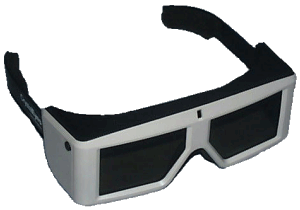
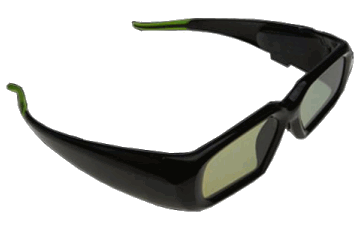
RealD 3D uses a single high resolution digital projector (some older 3D technologies required 2 projectors) and a special more expensive silver screen to produce 3D images. Even with the special screen, RealD 3D is still the most inexpensive and most popular of the newer 3D technologies. The circular polarized glasses are also cheap to produce, compared with Dolby 3D or LCD Shutter glasses.
The projector displays 144 frames per second, 72 frames for each eye. Note that the raw video footage is only 24 frames per second. Each individual frame is projected 3 times per eye to reduce flickering problems. Each frame is polarized by the projector clockwise for the right eye and counterclockwise for the left eye using a special device called a Z-Screen modulator which is placed directly in front of the projector. The special RealD 3D Silver Screen is required to maintain the polarization produced by the Z-Screen.
The 3D effect with RealD 3D and Dolby 3D is more natural than older stereoscopic or IMAX technologies. The first 3D movies had special 3D scenes when the user wore glasses, but most of the movie was 2D. These 3D scenes tended to put the action right in your face for an overwhelming effect. The newer 3D technologies are more realistic and muted, and some might find it underwhelming at first. Still, if you are going to watch an entire 3D movie wearing glasses, you need it to be more realistic so that it doesn't hurt your brain.
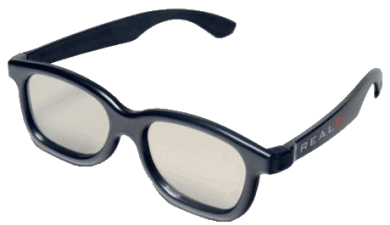
Analog IMAX theaters use a large 70mm film (vs. 35mm) to get the much higher resolution needed for the larger screen. The IMAX linear polarized glasses are very large and some people have a problem with the fit of these glasses. Also, as discussed above using linear polarization means that the viewer must stare at the center of the screen or the image will appear blurry.
IMAX introduced a digital version in 2008 but it is not widely adopted because of cost and other issues. The digital version doesn't have as large as screen as a standard IMAX theater, and the glasses cost more.
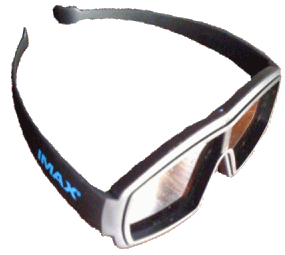
Dolby 3D Digital Cinema uses polarization combined with special colored filters to produce a better 3D image. Dolby 3D doesn't require a special silver screen to maintain the polarization, but the glasses are more expensive. As with RealD 3D, the viewer can move their head around and has almost no ghosting effect.
Compared with other 3D technologies, Dolby 3D has a sharper image and brighter and more vivid colors, and better contrast, especially in the darker areas of the image.
